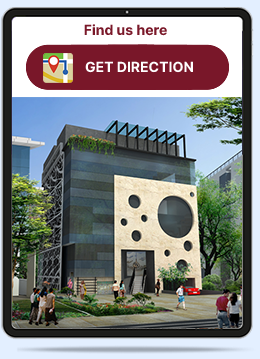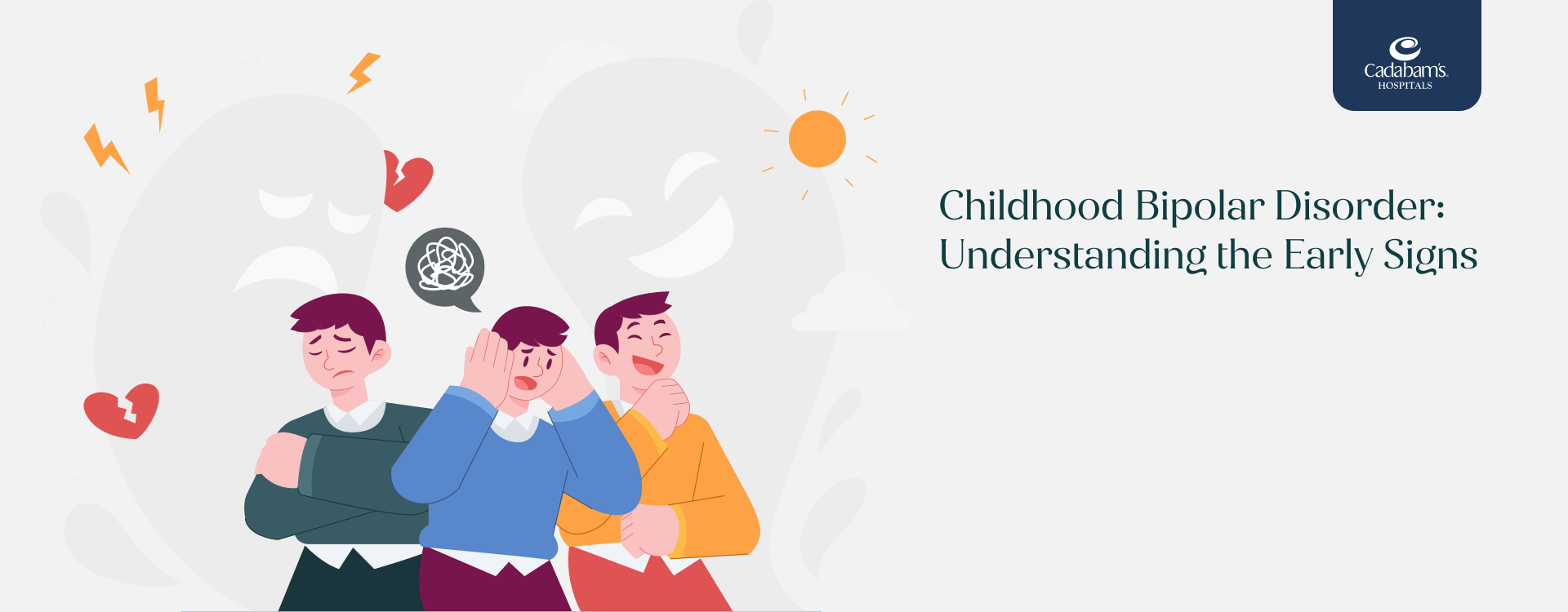Table of Content
Parenting is a mix of joy, reward, and challenge. As your children grow, it is natural to see many changes in them. These changes are majorly seen in their mental, emotional, and physical aspects. Sometimes these changes create a little confusion and make you wonder if this is just the process of growing up or indicating some underlying mental conditions like bipolar disorder.
In fact, 65% percent of adults with bipolar disorder experience its symptoms before the age of 18. So, let’s understand how you can recognize bipolar disorder symptoms in children and what are the available treatments for this illness.
What is Bipolar Disorder in Children?
We know bipolar disorder is a mental condition that causes severe mood swings with episodes of mania, hypomania, and depression. However, it is a lot different in children than adults, making the illness a lot more challenging to diagnose in children.
In adults, the periods of mania, hypomania, and depression usually stay for a longer for a longer duration, and the transition from mania to depression is quite visible.
However, in the case of children, it is different. They tend to experience mood swings faster, and the symptoms may occur several times a day. They also experience the symptoms of mania and depression simultaneously.
How Does Bipolar Disorder Impact Children
Bipolar disorder impacts the lives of children and teenagers in numerous ways. As said in the above section, episodes of high and low occur more rapidly in children and teenagers, making diagnosing difficult.
The illness can also impact other aspects of the lives of children. For example, academic performance, concentration, sleep pattern, sudden dip and high energy level, self-harm thoughts, inability to think clearly, etc. Another aspect is their relationships with family, friends, and other social groups.
Recognizing the Symptoms of Bipolar Disorder in Children and Teens
Children and teens with bipolar disorder experience intense highs and lows of mania and depression. When they are experiencing these episodes, they exhibit signs that can help them recognize bipolar disorder in children. Here are some signs associated with manic and depressive episodes.
Signs and Symptoms of Manic Episodes
Unlike adults, when a child goes through a period of a manic episode, they tend to be more irritated than happy and may display the below-listed signs:
| Overly Happy and Excited | Unusually Impatient | Too Much Energy |
| No Sleep for Days | Lack of Concentration | Unusually Irritable |
| Switch Topics Rapidly | Overly Interested | Reckless |
| Very Talkative | Defiant | Lack of Seriousness |
Signs and Symptoms of Depressive Episodes
Depressive episodes of bipolar disorder illustrate the opposite of manic episodes, and these are:-
| Overly Sad | Uninterested in Things Previously Enjoyed | Low Energy |
| Sleep too much or Lack of Sleep | Poor Academic Performance | Self-Harm Thoughts |
| Low Confidence | Headaches | Stomach Pain |
| Irritated | Sensitive to Rejection/ Failure | Lack of Interest in School and Friends |
Causes of Bipolar Disorder in Children and Adolescents
We don’t know what exactly causes bipolar disorder. However, scientists believe that it may be a culmination of multiple facts, and these are:-
Genetic Factors
Genetics is believed to be one of the primary factors of bipolar disorder. Close to 80% of the total cases of bipolar disorder have links to genetics. A few studies suggest that if one of the parents has bipolar disorder, then there is a 10% chance that the illness will be passed on to the next generation. If both parents have the condition, then the passed-on percentage increases to 44%. Though, more studies are required to fully understand its role in bipolar disorder.
Brain Structure and Function
Bipolar disorder is closely linked to brain structure and its function. The illness also causes certain regions of the brain to shrink. A 2017 study analyzed brain scans and found that the condition causes a decrease in gray matter thickness in the frontal, temporal, and parietal lobes. All these changes influence emotions, thinking, concentration, sleep, and cognitive functions.
Neurochemical Imbalances
Neurochemicals such as dopamine, serotonin, noradrenaline, etc., are responsible for controlling our brain’s function. Any imbalance in these neurotransmitters can cause symptoms of bipolar disorder. For example, if the level of the brain chemical noradrenaline is too high or too low, it may cause episodes of bipolar mania and depression.
Environmental Triggers
Bipolar disorder is a complex condition, and many factors play roles in its development in individuals. The environment or the surroundings we grow up in is one such factor that can cause bipolar disorder. For example, traumatic events in childhood, Stressful life events, substance abuse, etc. can greatly contribute.
Diagnosing Bipolar Disorder in Children
Diagnosing bipolar disorder in children isn’t easy. Reasons like overlapping symptoms, difficulty in expressing emotion due to relatively young age, etc., make diagnosing a difficult task. However, mental health specialists use multiple tools like physical examination, medical history, mental health evaluation, etc., to determine whether the child has bipolar disorder or not.
Why Early Diagnosis Important in Children with Bipolar Disorder
Like in any illness, early diagnosis has its share of benefits and advantages, especially for children experiencing mental health issues like bipolar disorder. Early interventions allow mental health professionals to implement treatments that can help in better management of bipolar symptoms throughout the child’s life. Consequently, improving quality of life and effectively reducing future episodes of depression and mania. All these effective strategies bring better long-term results.
Differentiating from Other Disorders
Another vital aspect of bipolar disorder is accurate diagnosis. Because of its similarity with other disorders, any misdiagnosis can impede proper treatments. Here's how bipolar disorder can differ from other common conditions:-
- ADHD: While ADHD and bipolar disorder have hyperactivity and impulsivity, the latter is chaperoned by extreme mood swings (mania and depression). ADHD generally causes attention difficulty but not mood swings.
- Depression: As far as chronic depression is concerned, it is characterized by long-lasting sadness, lack of motivation, and absence of euphoric episodes, which is very much visible in bipolar disorder.
Treatment Options for Children with Bipolar Disorder
Bipolar disorder is considered to be a life-long condition, and the focus of treatments is majorly on managing symptoms and developing coping strategies. These treatments are often combined with medications and psychotherapy. Here are some of the main treatments for pediatric bipolar disorder and other related information.
Medication for Children with Bipolar Disorder
Prescribed medicines like mood stabilizers and antipsychotic drugs are quite effective in treating bipolar disorder. These medications help in managing mood swings and other symptoms that are related to bipolar disorder.
When it comes to medications, parents are naturally concerned about side effects. So, let’s discuss them.
Side Effects of Bipolar Medication in Children
Understanding the side effects of bipolar medications is a little tricky due to the limited number of studies being done on this subject. However, some of the side effects of bipolar medication in children are:-
- Nausea and Vomiting
- Weight Gain
- Sedation
- Insomnia
- Alopecia
- Tremor
- Dizziness
- Drowsiness
- Tiredness
Psychotherapy for Children with Bipolar Disorder
Psychotherapy is one of the most effective, evidence-backed treatments for bipolar disorder. In simple terms, psychotherapy refers to a wide range of treatments that aim to help people change their thinking, emotions, and behavior through a medium of conversation with licensed mental health professionals. Here are some of the therapies used to treat bipolar disorder in children.
Psychoeducation
It is a structured way of sharing information about a person's mental health condition. Under this therapy, mental health professionals also share information on diagnosis, symptoms, and treatment plans.
Cognitive Behavioral Therapy (CBT)
CBT is a gradual way of teaching people with bipolar disorder how to identify and change thought patterns that are negatively influencing their behavior. The therapy is done through the medium of talk.
Family-Focused Therapy (FFT)
FFT not just focuses on individuals with bipolar disorder but also concentrates on the entire family. The therapy very well understands family dynamics that have the potential to influence the person’s recovery and condition. FFT also shares the traits of psychoeducation in sharing knowledge.
Interpersonal and Social Rhythm Therapy (IPSRT)
IPSRT is based on the idea that even slight changes have the potential to cause mood swings in people with bipolar disorder. Thus, it aims to minimize disruptions in daily routines, and our internal clock called the “circadian rhythms,” which regulate our wake-up and sleep cycle.
Dialectical Behavior Therapy (DBT)
It is also a type of talk therapy, specifically designed for people who go through high and intense emotions. The therapy helps people understand and come to terms with the reality of their life and their behavior. Along with this, the therapy also teaches how to change their lives and behaviors that are causing them trouble.
Chronotherapy
In one of the above sections, we discussed circadian rhythms which is an internal clock in the body that manages our sleep and wake-up cycle. This cycle gets out of sync in people with bipolar disorder and Chronotherapy stabilizes, resets, and regulates our internal clock which helps in managing bipolar disorder symptoms.
Lifestyle Changes and Support
Many articles and studies have shown the importance of a healthy lifestyle to maintain physical and mental well-being. Along with medication and therapy, lifestyle changes can work wonders for people with mental health illnesses. Some small lifestyle changes like regular exercise, walking, socialization, reading, journaling, eliminating alcohol and tobacco consumption, adopting a balanced diet, sleep hygiene, etc can bring unparalleled benefits.
When to Seek Help for Bipolar Disorder in Children and Adolescents
Children with bipolar disorder show extreme mood swings, but it’s not always easy for parents to understand and realize when to seek professional help. So, here are a few signs that may indicate that it’s time for you to seek help.
- Behavior problems interfering with daily life
- Are they able to attend school?
- Are they able to engage in play with other kids?
- If they are self-doubting and feel something wrong with them
- Family history
- Talk or behave in a way that is unusual for their age
- Find it difficult to perform even normal task
Addressing Risks in Teens with Bipolar Disorder
Teens with bipolar disorder face greater risks of substance abuse, self-harm, and suicidal tendencies, which are some of the major concerns in teens. Numerous studies indicate a significant increase in suicide attempts compared to the general population. Addressing these risks requires working closely with healthcare professionals to assess the teen's specific needs and how to implement a safety plan.
Co-Morbid Conditions in Children with Bipolar Disorder
Previously we discussed that bipolar disorder symptoms are very similar to other mental illnesses and this makes diagnosis a challenging task. But many a time, these overlapping symptoms do indicate the presence of other mental health conditions. These claims have been backed by numerous studies.
According to one study, the prevalence of anxiety disorder in youth with bipolar disorder is 54%, followed by ADHD (48%), disruptive behavior disorder (31%), and substance use disorder (31%).
Supporting Your Child with Bipolar Disorder at School and Home
A supportive home environment plays a vital role for any child, and even more so for one managing bipolar disorder. Here are some basic things you can do to support your child at school and home.
Collaborating with Schools for Tailored Educational Support
For academic support, parents can work closely with school officials who can tailor suitable schedules that will support the child’s education.
Developing an Individualized Education Plan (IEP)
An individualized education plan can be an effective way to implement all the educational needs of your child. By maintaining a constant line of communication with teachers can help you adjust your child’s workload and schedule as needed.
Behavioral Support in School
School officials including teachers and potential school psychologists can create a behavior plan, encourage positive behavior, and take disciplinary action whenever needed.
Academic Assistance
Schools often offer supportive services to ensure that the children can continue their education effectively. These services may include accommodations such as a modified schedule or allowing your child to visit the guidance counselor as needed.
Enhancing Support at Home
Bipolar disorder can change the dynamics of a family, hence it is important to create a supportive home environment. Here are some tips you can implement to enhance your kid's support at home.
Educating the Family
Each member of the family needs to know about bipolar disorder, so gain as much as knowledge about bipolar disorder. When you have a good knowledge of the symptoms, triggers, and phases of bipolar disorder, you understand your child’s emotional and behavioral state in much better ways.
Open Communication About Treatment
Open communication is the key; keep an open and healthy conversation with your child about treatment. This will help them understand the roles of treatment in their illness.
Self-Care for Parents
Caregiving isn’t easy, and you can help your child only if you are feeling well. So, take care of yourself, get proper sleep, eat a balanced diet, meditate, and, most importantly, be easy on yourself, especially when things aren’t going the way they should.
A Brighter Tomorrow with Cadabams: Supporting Children and Teens with Bipolar Disorder
Bipolar disorder in children and teens presents unique challenges. Mood swings can disrupt their academic performance, social interactions, and overall well-being. Caregivers often face immense strain, struggling to understand the condition and manage its unpredictable nature.
At Cadabams, we offer a range of comprehensive services tailored to support your child's mental health journey. From personalized treatment plans to state-of-the-art facilities and a team of experienced professionals, we are committed to providing the highest quality care. So, let’s create a brighter tomorrow for you and your child with Cadabams.
If you are searching for a solution to your problem, Cadabam’s Hospitals can help you with its team of specialized experts. We have been helping thousands of people live healthier and happier lives for 30+ years. We leverage evidence-based approaches and holistic treatment methods to effectively treat bipolar disorder in children and teens. Get in touch with us today. You can call us at +91 97414 76476. You can even email us at info@cadabamshospitals.com.
FAQ
1. How does bipolar disorder affect children's daily lives?
Bipolar disorder in children can disrupt daily life with mood swings, affecting concentration, relationships, and school performance. Episodes of mania may lead to impulsivity and risky behavior, while depressive episodes can cause withdrawal and difficulty functioning.
2. How is bipolar disorder diagnosed in children?
Bipolar disorder in children is diagnosed through a comprehensive evaluation by mental health professionals. Criteria include mood swings, changes in energy, sleep disturbances, and risky behavior. Assessments involve interviews, observation, and medical history review. Differential diagnosis is crucial to rule out other conditions.
3. How can I help my child with bipolar disorder?
Support your child with bipolar disorder by maintaining a consistent routine, providing a safe and understanding environment, educating yourself about the condition, ensuring they have access to proper medication and therapy, and fostering open communication. Seek guidance from mental health professionals for personalized strategies and support.
4. What treatments are available for children with bipolar disorder?
Treatment options for children with bipolar disorder include medication, therapy, and lifestyle adjustments. Medications like mood stabilizers or atypical antipsychotics may be prescribed to manage symptoms. Therapy, such as cognitive-behavioral therapy, can help children learn coping strategies. Lifestyle changes like maintaining a regular schedule and healthy habits are also beneficial.
5. How can psychotherapy help children with bipolar disorder?
Psychotherapy for children with bipolar disorder aims to provide coping skills, emotional regulation techniques, and support in understanding and managing their symptoms. Therapists work with children and their families to identify triggers, improve communication, and enhance problem-solving abilities, fostering stability and improved quality of life.
How Cadabam's Help you for Addiction?
- 410+ Professional Consultants
- 1,00,00+ Happy Faces
- 120+ Currently Seeking Treatments










